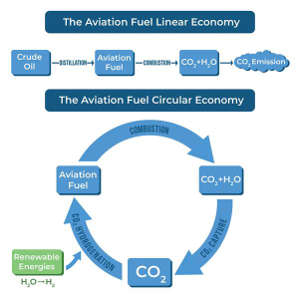Using AI to control energy for indoor agriculture
30 September 2024
Published online 13 January 2021
A method that converts carbon dioxide directly into liquid hydrocarbon fuel could pave the way to carbon-neutral air travel.

Peter Edwards
Enlarge image
Now, researchers at the KACST-Oxford Centre of Excellence in Petrochemicals at the University of Oxford, UK, have demonstrated direct conversion of carbon dioxide (CO2) and hydrogen into a hydrocarbon liquid fuel that may be viable for use in jet engines. The team says this is the first time this has been achieved; other methods require several intermediate steps.
“Finding ways to recycle CO2 efficiently into fuels and valuable chemicals could make a significant contribution to a circular carbon-neutral economy,” says Tiancun Xiao, who worked on the project with Peter Edwards, Benzhen Yao and colleagues at KACST-Oxford, together with scientists across the UK and Saudi Arabia.
The main components of aviation fuels are hydrocarbons with carbon chain lengths of C8 to C16. To hydrogenate CO2, a reaction is triggered using a catalyst together with hydrogen gas. The team used an existing energy-efficient method to develop an iron-based catalyst that can convert CO2 with a high selectivity for jet fuel-range hydrocarbons.
“Iron is an inexpensive, abundant component,” says Xiao. The research team incorporated manganese and potassium into the catalyst to improve its performance. “The preparation of our catalyst produces a little water, and some gases that can be recovered and purified, so the process is clean and cost-effective.”
Trials to convert CO2 using the catalyst showed strong hydrogenation activity, and improved selectivity for jet fuel-range hydrocarbons compared with other iron-based catalysts. The conversion process also produced light olefins including ethylene and butene, which are critical raw materials in the petrochemical industry.
“Our conversion method makes use of existing technologies and would be easily scalable. With the right policy and financial support, it could reach the aviation industry quickly,” says Edwards.
“The possibility of recycling captured CO2 into aviation fuel opens the door to CO2-neutral air travel, with obvious positive consequences.” says Jorge Gascon, who was not involved in the study. “This study represents a step forward in this endeavour. The next steps should include further increasing hydrocarbon chain length and degree of branching; both are vital for this specific application,” adds Gascon, who is director of the King Abdullah University of Science and Technology Catalysis Center, Saudi Arabia.
The KACST-Oxford team are working on optimizing their conversion method and catalyst performance, and hope to build the world’s first net-zero aviation fuel demonstration plant with the help of an industrial collaborator.
doi:10.1038/nmiddleeast.2021.4
Yao, B. et al. Transforming carbon dioxide into jet fuel using an organic combustion-synthesized Fe-Mn-K catalyst. Nat. Commun. 11, 6395 (2020).
Stay connected: